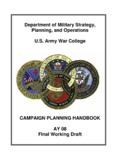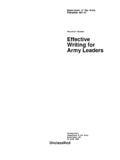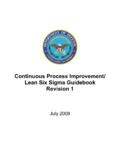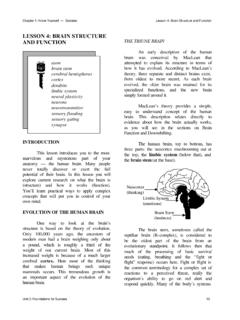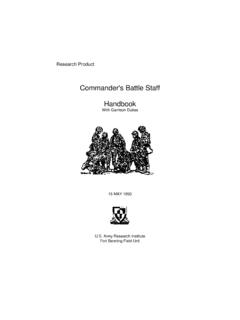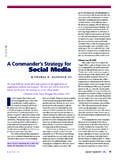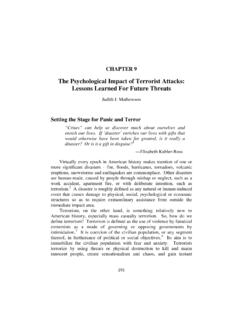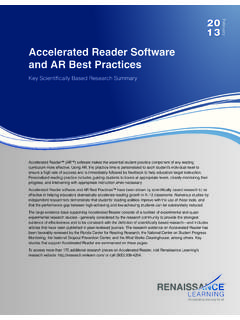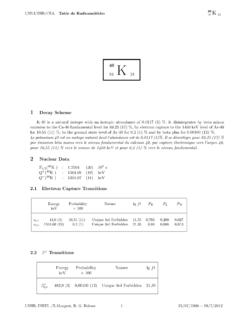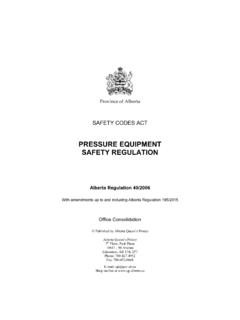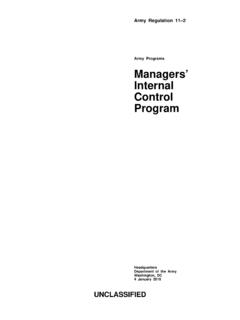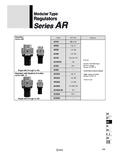Transcription of Medical Services Standards of Medical Fitness - Air University
1 Army Regulation 40 501 Medical ServicesStandards ofMedicalFitnessHeadquartersDepartment of the ArmyWashington, DC29 August 2003 UNCLASSIFIEDSUMMARY of CHANGEAR 40 501 Standards of Medical FitnessThis revision, dated 29 August 2003--o Clarifies the Medical examination requirements for Army aviation (chaps 4 and6).o Deletes flying duty Class 2S (chaps 4 and 6).o Expands the physical profiling authority for podiatrists (para 7-6a(5)).o Adds requirements for the Medical examinations for Ranger School applicants(para 8-12k).o Changes the requirements for age specific periodic Medical examinations to anevery 5 year schedule (para 8-19c(3)).o Deletes the requirement to have a duplicate Medical examination recorded onDD Form 2808 (Report of Medical Exam) if a separation Medical examination hasalready been completed by the Department of Veterans Affairs (para 8-23e).o Rescinds DA Form 5675 (Health Risk Appraisal).This administrative revision dated 30 September 2002--o Corrects an error in the conditions of the lower extremities that are causesfor rejection for appointment, enlistment, and induction (para 2-10c(2)).
2 O Corrects an error in a paragraph reference for certain physical exams (para10-23d).o Includes correction of publication titles and sources in appendix revision (dated 28 March 2002)--o Revises the list of authorities who approve waivers for the Medical fitnessstandards contained in chapters 2, 3, 4, or 5 (para 1-6).o Revises the Medical accession Standards in compliance with DOD , Physical Standards for Appointment, Enlistment, or Induction, 15 December 2000, and DOD Instruction , Criteria and ProcedureRequirements for Physical Standards for Appointment, Enlistment, orInduction in the Armed Forces, 14 December 2000 (chap 2).o Adds the International Classification of Disease codes for Medical conditionscausing rejection for appointment, enlistment, and induction (chap 2).o Revises the Medical retention Standards , including new Standards on asthma(chap 3).o Adds metabolic equivalent testing to functional classifications of patientswith cardiovascular disease (table 3-1).
3 O Revises the aviation chapters (chap 4 and chap 6).o Reduces the number of physician signatures on permanent 3 or 4 profiles (chap7) and updates the description of profile codes (table 7-1).o Adds occupational history requirements to the pregnancy profile (chap 7).o Replaces SF 93 (Report of Medical History) and SF 88 (Report of MedicalExamination) with two new forms, DD Form 2807-1 (Report of Medical History)and DD Form 2808 (Report of Medical Examination) (chap 8 and table 8-1).o Revises the Cardiovascular Screening program requirements (chap 8).o Adds policies for Medical examinations and physical Standards for the ArmyNational Guard (chap 10).o Rescinds DA Form 4970 and DA Form 4970-E ( Medical Screening Summary--Over 40 Physical Fitness Program).HeadquartersDepartment of the ArmyWashington, DC29 August 2003 Medical ServicesStandards of Medical Fitness *Army Regulation 40 501 Effective 29 September 2003 History. This publication is a rapid actionr e v i s i o n.
4 T h e p o r t i o n s a f f e c t e d b y t h i sr e v i s i o n a r e l i s t e d i n t h e s u m m a r y o This regulation provides in-formation on Medical Fitness Standards forinduction, enlistment, appointment, reten-tion, and related policies and publication implements DOD Direc-tive , Physical Standards for Ap-p o i n t m e n t , E n l i s t m e n t , a n d I n d u c t i o n ,December 15, 2000, and DOD , Criteria and Procedure Require-ments for Physical Standards for Appoint-m e n t , E n l i s t m e n t , o r I n d u c t i o n i n t h eArmed Forces, December 14, This regulation applies tocandidates for military service and to Ac-tive Army personnel. It also applies to theArmy National Guard of the United Statesand the Army Reserve. This publica-tion is applicable during and exception proponent of this regulation is theOffice of the Surgeon General.
5 The pro-ponent has the authority to approve ex-c e p t i o n s t o t h i s r e g u l a t i o n t h a t a r econsistent with controlling law and regu-lation. Proponents may delegate the ap-proval authority, in writing, to a divisionchief within the proponent agency in thegrade of colonel or the civilian management control regulation contains management con-trol provisions, but it does not identifyk e y m a n a g e m e n t c o n t r o l s t h a t m u s t b u p p l e m e n t a t i o n . S u p p l e m e n t a t i o n o fthis regulation and establishment of com-mand or local forms are prohibited with-o u t p r i o r a p p r o v a l f r o m H Q D A( D A S G H S A S ) , 5 1 0 9 L e e s b u r g P i k e ,Falls Church, VA 22041 improvements. Users areinvited to send comments and suggestedimprovements on DA Form 2028 (Recom-m e n d e d C h a n g e s t o P u b l i c a t i o n s a n dB l a n k F o r m s ) d i r e c t l y t o H Q D A( D A S G H S A S ) , 5 1 0 9 L e e s b u r g P i k e ,Falls Church, VA 22041 This publication is availa-ble in electronic media only (EMO), andis intended for command levels A, B, C,D, and E for Medical activities only of theActive Army, the Army National Guardof the United States, and the (Listed by paragraph and page number)
6 Chapter 1 General Provisions, page 1 Purpose 1 1, page 1 References 1 2, page 1 Explanation of abbreviations and terms 1 3, page 1 Responsibilities 1 4, page 1 Medical classification 1 5, page 1 Review authorities and waivers 1 6, page 1 Chapter 2 Physical Standards for Enlistment, Appointment, and Induction, page 2 General 2 1, page 2 Application and responsibilities 2 2, page 2 Abdominal organs and gastrointestinal system 2 3, page 3 Blood and blood-forming tissue diseases 2 4, page 4*This regulation supersedes Army Regulation 40 501, dated 30 September 2002, and rescinds DA Form 5675, February 40 501 29 August 2003iUNCLASSIFIEDC ontents ContinuedDental 2 5, page 4 Ears 2 6, page 5 Hearing 2 7, page 5 Endocrine and metabolic disorders 2 8, page 5 Upper extremities 2 9, page 5 Lower extremities 2 10, page 6 Miscellaneous conditions of the extremities 2 11, page 7 Eyes 2 12, page 7 Vision 2 13, page 8 Genitalia 2 14, page 9 Urinary system 2 15, page 9 Head 2 16, page 10 Neck 2 17, page 10 Heart 2 18, page 10 Vascular system 2 19, page 11 Height 2 20, page 11 Weight 2 21, page 11 Body build 2 22, page 11 Lungs, chest wall, pleura, and mediastinum 2 23, page 11 Mouth 2 24, page 12 Nose, sinuses, and larynx 2 25, page 12 Neurological disorders 2 26, page 12 Disorders with psychotic features 2 27, page 13 Neurotic, anxiety, mood, somatoform, dissociative, or factitious disorders 2 28, page 13 Personality, conduct, and behavior disorders 2 29, page 13 Psychosexual conditions 2 30, page 13 Substance misuse 2 31, page 14 Skin and cellular tissues 2 32.
7 Page 14 Spine and sacroiliac joints 2 33, page 15 Systemic diseases 2 34, page 15 General and miscellaneous conditions and defects 2 35, page 16 Tumors and malignant diseases 2 36, page 16 Miscellaneous 2 37, page 16 Chapter 3 Medical Fitness Standards for Retention and Separation, Including Retirement, page 18 General 3 1, page 18 Application 3 2, page 18 Disposition 3 3, page 18 General policy 3 4, page 19 Abdominal and gastrointestinal defects and diseases 3 5, page 19 Gastrointestinal and abdominal surgery 3 6, page 19 Blood and blood-forming tissue diseases 3 7, page 20 Dental diseases and abnormalities of the jaws 3 8, page 20 Ears 3 9, page 20 Hearing 3 10, page 20 Endocrine and metabolic disorders 3 11, page 21 Upper extremities 3 12, page 21 Lower extremities 3 13, page 21 Miscellaneous conditions of the extremities 3 14, page 22 Eyes 3 15, page 22 Vision 3 16, page 23 Genitourinary system 3 17, page 23 Genitourinary and gynecological surgery 3 18, page 24 Head 3 19, page 24iiAR 40 501 29 August 2003 Contents ContinuedNeck 3 20, page 24 Heart 3 21, page 24 Vascular system 3 22, page 25 Miscellaneous cardiovascular conditions 3 23, page 26 Surgery and other invasive procedures involving the heart, pericardium, or vascular system 3 24, page 26 Trial of duty and profiling for cardiovascular conditions 3 25, page 26 Tuberculosis, pulmonary 3 26, page 27 Miscellaneous respiratory disorders 3 27, page 27 Surgery of the lungs 3 28, page 28 Mouth, esophagus, nose, pharynx, larynx, and trachea 3 29, page 28 Neurological disorders 3 30.
8 Page 28 Disorders with psychotic features 3 31, page 29 Mood disorders 3 32, page 29 Anxiety, somatoform, or dissociative disorders 3 33, page 29 Dementia and other cognitive disorders due to general Medical condition 3 34, page 29 Personality, sexual and gender identity, or factitious disorders; disorders of impulse control not elsewhere classified;substance-related disorders 3 35, page 29 Adjustment disorders 3 36, page 29 Eating disorders 3 37, page 30 Skin and cellular tissues 3 38, page 30 Spine, scapulae, ribs, and sacroiliac joints 3 39, page 30 Systemic diseases 3 40, page 31 General and miscellaneous conditions and defects 3 41, page 32 Malignant neoplasms 3 42, page 32 Benign neoplasms 3 43, page 32 Sexually transmitted diseases 3 44, page 32 Heat illness and injury 3 45, page 33 Cold injury 3 46, page 33 Chapter 4 Medical Fitness Standards For Flying Duty, page 35 General 4 1, page 35 Classes of Medical Standards for flying and applicability 4 2, page 35 Aeromedical consultation 4 3, page 36 Abdomen and gastrointestinal system 4 4, page 36 Blood and blood forming tissue diseases 4 5, page 36 Dental 4 6, page 36 Ears 4 7.
9 Page 37 Hearing 4 8, page 37 Endocrine and metabolic diseases 4 9, page 37 Extremities 4 10, page 37 Eyes 4 11, page 37 Vision 4 12, page 38 Genitourinary 4 13, page 39 Head and neck 4 14, page 39 Heart and vascular system 4 15, page 39 Linear anthropometric dimensions 4 16, page 40 Weight and body build 4 17, page 40 Lung and chest wall 4 18, page 40 Mouth 4 19, page 40 Nose 4 20, page 40 Pharynx, larynx, trachea, and esophagus 4 21, page 41 Neurological disorders 4 22, page 41 Mental disorders 4 23, page 42 Skin and cellular tissues 4 24, page 43iiiAR 40 501 29 August 2003 Contents ContinuedSpine, scapula, ribs, and sacroiliac joints 4 25, page 43 Systemic diseases 4 26, page 43 Malignant diseases and tumors 4 27, page 43 Sexually transmitted diseases 4 28, page 43 Aeromedical adaptability 4 29, page 43 Reading Aloud Test 4 30, page 44 Department of the Army civilian and contract civilian aircrew members 4 31, page 44 Medical Standards for Class 3 personnel 4 32, page 45 Medical Standards for civilian ATC personnel 4 33, page 45 Chapter 5 Medical Fitness Standards for Miscellaneous Purposes, page 46 General 5 1, page 46 Application 5 2, page 46 Medical Fitness Standards for initial selection for Airborne training, Ranger training, and Special Forces training 5 3, page 46 Medical Fitness Standards for selection for survival, evasion, resistance, escape training 5 4, page 48 Medical Fitness Standards for retention for Airborne duty, Ranger duty, and Special Forces duty 5 5, page 49 Medical Fitness Standards for initial selection for free fall parachute training 5 6.
10 Page 49 Medical Fitness Standards for retention for free fall parachute duty 5 7, page 50 Medical Fitness Standards for Army service schools 5 8, page 51 Medical Fitness Standards for initial selection for marine diving training (Special Forces and Ranger combat diving) 5 9, page 51 Medical Fitness Standards for retention for marine diving duty (Special Forces and Ranger combat diving) 5 10,page 52 Medical Fitness Standards for initial selection for other marine diving training (MOS 00B) 5 11, page 52 Medical Fitness Standards for retention for other marine diving duty (MOS 00B) 5 12, page 54 Asplenic soldiers 5 13, page 54 Medical Fitness Standards for certain geographical areas 5 14, page 54 Height Military Academy, Reserve Officers Training Corps, and Uniformed Services University of HealthSciences 5 15, page 55 Chapter 6 Aeromedical Administration, page 55 General 6 1, page 55 Definition of terms 6 2, page 56 Application 6 3, page 56 Responsibilities 6 4, page 56 Authorizations 6 5, page 57 Classification of FDMEs 6 6, page 57 Purpose of FDMEs 6 7, page 57 Frequency and period of validity of FDMEs 6 8, page 58 Facilities and examiners 6 9, page 59 Disposition and review of FDMEs 6 10, page 59 Issuing DA Form 4186 6 11, page 60 General principles 6 12, page 61 Responsibilities and review following a change in health of aircrew members 6 13.
